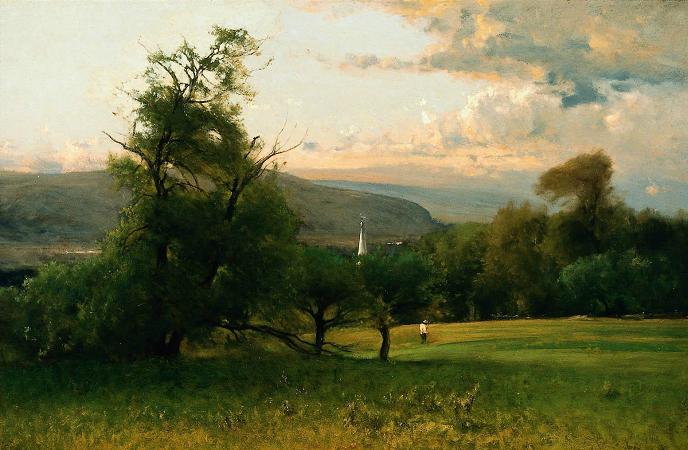Jean Baptiste Camille Corot (1796 - 1875). Jean-Baptiste-Camille Corot was a French landscape and portrait painter as well as a printmaker in etching. He is a pivotal figure in landscape painting and his vast output simultaneously references the Neo-Classical tradition and anticipates the plein-air innovations of Impressionism. Jean-Baptiste-Camille Corot was born in Paris on July 16, 1796, in a house at 125 Rue du Bac, now demolished. His family were bourgeois people, his father was a wigmaker and his mother a milliner, and unlike the experience of some of his artistic colleagues, throughout his life he never felt the want of money, as his parents made good investments and ran their businesses well. After his parents married, they bought the millinery shop where his mother had worked and his father gave up his career as a wigmaker to run the business side of the shop. The store was a famous destination for fashionable Parisians and earned the family an excellent income. Corot was the second of three children born to the family, who lived above their shop during those years. Corot received a scholarship to study at the Lycee Pierre-Corneille in Rouen, but left after having scholastic difficulties and entered a boarding school. He was not a brilliant student, and throughout his entire school career he did not get a single nomination for a prize, not even for the drawing classes. Unlike many masters who demonstrated early talent and inclinations toward art, before 1815 Corot showed no such interest. During those years he lived with the Sennegon family, whose patriarch was a friend of Corot's father and who spent much time with young Corot on nature walks. It was in this region that Corot made his first paintings after nature. At nineteen, Corot was a big child, shy and awkward. He blushed when spoken to. Before the beautiful ladies who frequented his mother's salon, he was embarrassed and fled like a wild thing. Emotionally, he was an affectionate and well-behaved son, who adored his mother and trembled when his father spoke. When Corot's parents moved into a new residence in 1817, the 21-year-old Corot moved into the dormer-windowed room on the third floor, which became his first studio as well. With his father's help Corot apprenticed to a draper, but he hated commercial life and despised what he called business tricks, yet he faithfully remained in the trade until he was 26, when his father consented to his adopting the profession of art. Later Corot stated, I told my father that business and I were simply incompatible, and that I was getting a divorce. The business experience proved beneficial, however, by helping him develop an aesthetic sense through his exposure to the colors and textures of the fabrics. Perhaps out of boredom, he turned to oil painting around 1821 and began immediately with landscapes. Starting in 1822 after the death of his sister, Corot began receiving a yearly allowance of 1500 francs which adequately financed his new career, studio, materials, and travel for the rest of his life. He immediately rented a studio on quai Voltaire. During the period when Corot acquired the means to devote himself to art, landscape painting was on the upswing and generally divided into two camps: onehistorical landscape by Neoclassicists in Southern Europe representing idealized views of real and fancied sites peopled with ancient, mythological, and biblical figures; and tworealistic landscape, more common in Northern Europe, which was largely faithful to actual topography, architecture, and flora, and which often showed figures of peasants. In both approaches, landscape artists would typically begin with outdoor sketching and preliminary painting, with finishing work done indoors. Highly influential upon French landscape artists in the early 19th century was the work of Englishmen John Constable and J. M. W. Turner, who reinforced the trend in favor of Realism and away from Neoclassicism. For a short period between 1821 and 1822, Corot studied with Achille Etna Michallon, a landscape painter of Corot's age who was a protege of the painter Jacques-Louis David and who was already a well-respected teacher. Michallon had a great influence on Corot's career. Corot's drawing lessons included tracing lithographs, copying three-dimensional forms, and making landscape sketches and paintings outdoors, especially in the forests of Fontainebleau, the seaports along Normandy, and the villages west of Paris such as Ville-d'Avray.
more...














